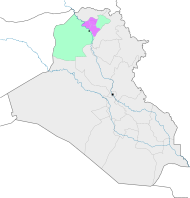Babirah
Babirah
Babira بابيرة | |
|---|---|
Village | |
| Coordinates: 36°32′37″N 43°1′27″E / 36.54361°N 43.02417°E | |
| Region | |
| Governorate | Nineveh Governorate (de jure) Dohuk Governorate (de facto) |
| District | Tel Kaif District |
Babirah (Arabic: بابيرة, Kurdish: بابیرێ, romanized: Babîrê)[1][2] is a village located in the Tel Kaif District of the Ninawa Governorate in northern Iraq. The village is located ca. 15 kilometres (9.3 mi) southwest of Telskuf in the Nineveh Plains. It belongs to the disputed territories of Northern Iraq.[3][4]
Babirah is populated by Yazidis.[4]
History

It was destroyed by ISIS in 2014, but rebuilt when the village was repopulated again by Yazidis
The village was originally an Assyrian village known as Bet Bore before it was settled by Yazidis and was known to contain an Assyrian population up until at least the 13th century.[6]
Yazidi holy sites
In Babira as well as the neighbouring town of Risala, the following Yazidi shrines are found:[7]
- Melik Şêxsin
- Balilê Habaş
- Şexsê Batê
References
- ^ "هۆلا لالش ل كۆمەلگەها بابیرێ هاتە نووژەنكرن" (in Kurdish). Archived from the original on 13 April 2020. Retrieved 19 December 2019.
- ^ "Ji ber Heşda Şeibî 6 qutabxaneyên kurdên êzîdî li Babîrê hatin girtin" (in Kurdish). 4 November 2017. Retrieved 19 December 2019.
- ^ "Bābirah populated place, Nīnawá, Iraq". iq.geoview.info. Retrieved 2018-12-22.
- ^ a b Saadi Azuo, Heerish (June 2016). "Graduate school of social sciences general psychology master's programme: Post-traumatic stress disorder among Ezidian women who escaped from ISIS capture" (PDF). Near East University. p. 10. Archived from the original (PDF) on 2020-04-13. Retrieved 2018-12-22.
- ^ Spät, Eszter. "Kurdish Studies - Persecution and the Development of Yezidi Ritual Life".
{{cite journal}}: Cite journal requires|journal=(help) - ^ Wilmhurst, David (2000). The Ecclesiastical Organization of the Church of the East, 1318-1913. p. 201.
- ^ Maisel, Sebastian (Spring 2021). "Rebuilding the unimagined past: Êzidî religious architecture and the reconfiguration of sacred space". Lalish. 45: 3–31.


